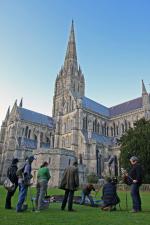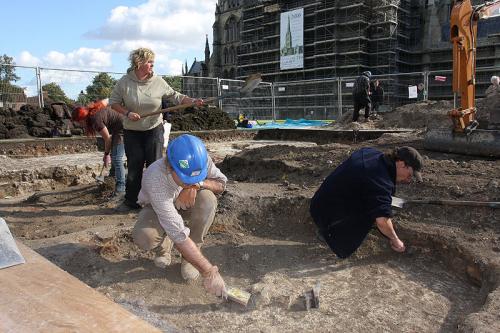(September/October 2008: Broadcast 8th February 2009)
With its graceful spire, Salisbury Cathedral is one of the most distinctive places of worship in Britain. It was founded in 1220 as part of the new foundation of the city of Salisbury. Unlike many other British cathedrals, Salisbury was built in a single architectural style - the main building was completed within 50 years of the foundation, and the tower and spire, added later, were complete by 1320.
Over the years the Cathedral has been subjected to many different studies in order to find out just how the medieval craftsmen put together this marvellous structure. Much has been revealed, but there are still questions to answer.
Two of these were on Time Team's list when they came to Salisbury in 2008. Two trenches were dug, the first to look at the site of the 13th century Bell Tower to the north of the Cathedral, and the second to look for the 15th century Chantry Chapel of Bishop Richard Beauchamp. In 2000 an evaluation by Cambrian Archaeological Projects, on the site of the Chantry Chapel, had found an in situ inhumation burial believed to be that of Bishop Beauchamp himself.
The first trench uncovered the foundations of the Bell Tower, as well as the remains of contemporary workshops which may have belonged to the craftsmen working on the Cathedral building. Later, the Bell Tower was used as an inn, before being demolished at the end of the 18th century.
In the Chantry Chapel trench, we found evidence for the preparation of the ground ready for the building of the Cathedral in 1220. The buttresses of the 1220 construction had been disturbed by the construction of the Beauchamp Chapel in the 15th century. The walls of the Chapel and four graves of the same date were exposed. Two of these graves were empty, and probably belonged to Bishop Beauchamp and John Cheney, whose tombs had been moved inside the Cathedral when the chapel was demolished in the 18th century. A third grave may be that of the Bishop's brother William, while the identity of the individual in the fourth grave remains unknown.
Read the full report here or visit the Wessex Archaeology Time Team section to find out more about our work on the programme.

